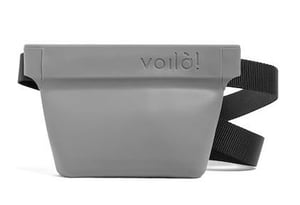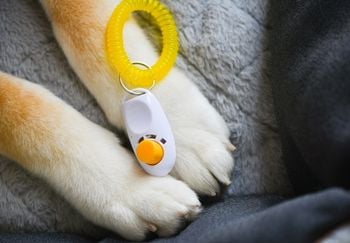 The absolute first thing I do with any dog I train is charge a marker.
The absolute first thing I do with any dog I train is charge a marker.
What is a marker in dog training? It's a word or sound that tells the dog "That! What you did right then is what gets you this treat!" The word acts as a bridge, giving us time to deliver the reward to our dog for a job well done.
Without a marker, we need to deliver a treat or reward within one second of the behavior occurring. That's tough if your dog is not right next to you or if your training treats are deep in your pocket.
A marker makes it easier to reward small movements your dog makes, creating more precise behaviors. It can also help a dog focus in distracting environments.
Having a way to tell your dog exactly what they got right creates clear communication and results in faster training. A marker word also means you can use different training techniques more effectively, such as capturing and shaping. And there's a bonus to using a marker in dog training — it helps prevent bribing your dog and makes fading out food treats easier in the long run!
Skip Ahead
Beyond having a shared "language" with my dog, my favorite thing about using a marker word is the shift in attitude it creates on the human side. We, humans, tend to be very reactive when it comes to our dog's behavior, and then get frustrated when we don't see training progress. We often fall into the habit of only responding to bad behaviors. It's important to teach our dogs what DOES work, not only tell them what doesn't.
Shifting our training from waiting for bad behaviors to looking for good behaviors — and then being able to tell our dogs they got it right — creates a stronger relationship and a dog who is trying to get you to say yes!
Marker Word Examples
In my experience, the most commonly used marker word is "yes!" But a marker word can be anything you'd like it to be, as long as it's a short word and easy to say. I also recommend using a word that you don't tend to use in normal conversations. You want your marker word to mean something powerful to your dog, so it shouldn't be something they hear over and over again without any associated reward (treat).
Popular Marker Word Options:
- Yes
- Yep
- Super
- Good
- Click
- *Tongue or Mouth Click* as an alternative to a spoken word
- *Thumbs Up* for deaf or dogs hard-of-hearing
How to Start Using a Marker Word with your Dog
Step One: Charge Your Marker Word!
- Have ten to twenty small training treats readily available. Using a treat pouch is ideal as it prevents your pockets from smelling like dog treats and makes it easy to grab and deliver a treat quickly to your dog.
 My favorite treat pouch for training treats is the Voilà Ultimate Treat Pouch. Made of high-quality silicone, it's perfect for holding pieces of string cheese, turkey hotdogs, or fresh chicken breast. I wear my Voilà pouch next to my regular treat pouch so that the moist treats don't intermingle with the dry treats to keep everything fresh and easy to clean.
My favorite treat pouch for training treats is the Voilà Ultimate Treat Pouch. Made of high-quality silicone, it's perfect for holding pieces of string cheese, turkey hotdogs, or fresh chicken breast. I wear my Voilà pouch next to my regular treat pouch so that the moist treats don't intermingle with the dry treats to keep everything fresh and easy to clean.
Save 10% on a Voilà Ultimate Treat Pouch by using the coupon code PV10.
- Say your marker word. Keep your body as still as possible when you say the word. This prevents your dog from learning "hand moving towards treat pouch" is the marker.
- Immediately give your dog a treat! Ideally, the treat follows within one second of the marker word.
- Repeat! Use up all your treats and then finish the training session with praise and some play for your dog.
When first introducing the word to your dog, you're only focused on creating an association that "yes" = treat. Your dog doesn't have to do anything in this step to earn the treat. However, don't say the marker word if your dog is doing something unwanted at that moment, such as jumping or barking.
Many dogs get the association very quickly, so charging a marker word usually doesn't take more than one or two sessions practicing the steps above. Check out this quick video showing how to charge a marker word:
Step Two: Use Your Marker Word!
You can begin using your marker word right away with your dog!
Capturing: Whenever your dog does something you like, say the marker word as they finish the behavior. Then reward them with a treat.
Shaping: Use your marker word to mark approximations of a larger training behavior. For example, teaching your dog to go to place. If they take one step towards their place, say the word, and then toss the treat away from the place (this resets them for the next repetition). Then wait until they take two steps before saying the word. Eventually, you'll have shaped the entire process of going to the place, laying down on the place, and staying on their place.
Luring or Prompting: You can use a treat in your hand (luring) to guide your dog into the position you're wanting to train. When they hit that position, say the word and then release the treat. To fade out treats in the hand, and prevent bribing in dog training, start using an empty hand (prompt) or hand signal to help them perform the behavior. Say the marker word as they finish the behavior or hit the correct position, then deliver the treat.
Tips for Using a Marker Word in Dog Training
- If you say the word, you must follow with the treat. Do not use the marker word if you do not have the treat to reward with afterward. Instead, just praise and reward with other rewards, such as toy rewards or real-life rewards.
- Aim to say the marker word consistently. The same tone of voice (positive and happy), same length of the word each time (don't drag it out), and same volume each time.
- Do not use the marker word to get your dog's attention. A marker is not a cue or command!
- Use your marker word especially for teaching new cues or when practicing behaviors around higher distractions or in new environments. This will help your dog generalize a behavior.
- As your dog advances through the training process for individual cues, you will not need to mark every successful response. You should still reward, whether with a treat, praise, play, or other reinforcement to maintain a behavior.

What's the Difference Between a Marker Word and a Clicker?
Marker words work the same way as clicker training your dog, but many clients of mine find it less complicated. Learning how to use a clicker can take time and practice for us humans. Plus, it can feel like one more thing you have to carry around with you. You always have your voice! Some dogs find the sound of a click too loud or scary, making using a word the best option.
However, a clicker is more precise than a marker word. It's much shorter than even a one-syllable word. A click will always sound the same, compared to the many ways a person can say the word "yes." Plus, a word will naturally sound different depending on who in your family is saying it. There are other benefits for using a clicker over a marker word, which Patricia McConnell talks about here.
I use both the marker word "yes" and a clicker with my dogs interchangeably. If I'm prepared and focused on training, such as in a group class, I'll use my clicker. But if I'm just hanging out in the kitchen at home or on a walk and my dog responds to a cue, I'll use "yes." But whichever one I'm using at the moment, I make sure that I am always prepared to reward with a treat right afterward.
Tell us about your dog in the comments! Do you use a marker word or clicker? What marker word do you use?



